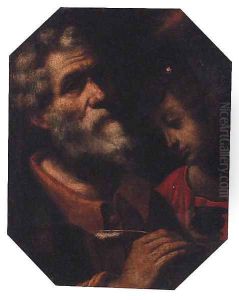Giovanni Battista Selvastrelli Paintings
Giovanni Battista Selvastrelli, born in 1837 in Italy, was a notable figure in the 19th-century art world, particularly within the Roman Catholic artistic tradition. Though not as widely recognized as some of his contemporaries, Selvastrelli's work played a significant role in the religious and artistic landscape of his time. He was deeply influenced by the spiritual and cultural milieu of Italy, which is vividly reflected in his artistic productions.
Selvastrelli's art career was largely devoted to religious themes, echoing the profound Catholic faith that underpinned much of Italian society during his lifetime. His works often depicted biblical scenes, saints, and figures from Christian tradition, imbued with a sense of devotion and a deep reverence for the divine. Selvastrelli's style, while rooted in the traditions of his predecessors, also exhibited a personal interpretation that made his work distinctive. He was part of a broader movement of 19th-century artists who sought to express their faith through art, contributing to the revival of religious art in Italy during this period.
Despite the specific focus on religious subjects, Selvastrelli's work was also appreciated for its technical skill and emotional depth. He had a keen ability to convey the spiritual and emotional intensity of his subjects, making his paintings resonate with viewers on multiple levels. Throughout his career, Selvastrelli engaged with various artistic mediums, but it was through painting that he expressed his most profound statements of faith and artistic vision.
Selvastrelli's contributions to art were part of a larger dialogue between the Church and the arts during a time of significant change and development in Italy. His works not only served a devotional purpose but also reflected the broader cultural and spiritual currents of his time. Selvastrelli passed away in 1905, leaving behind a legacy that, while perhaps not as widely recognized as that of some of his peers, remains an important testament to the role of religious art in the 19th century. His body of work continues to be studied by art historians and appreciated by those who seek to understand the intersection of faith and art in this dynamic period of Italian history.
